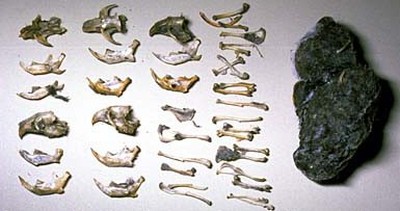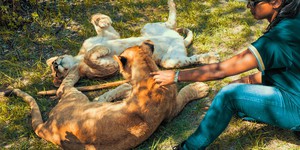Abstract
Are you fascinated by dinosaurs, fossilized bones, and fossilized plants? Although this project is not based on actual fossils, you will get good practice at reconstructing an animal's skeleton from individual bones. You'll use what you find to identify the types of prey that owls consume.Summary

Objective
The goal of this science project is to identify the types of prey that are consumed by owls by examining the contents of owl pellets.Introduction
It can be pretty hard to get an invitation to dig at an actual archaeological site. But don't let that deter you, you can still practice your bone identification and skeleton reconstruction skills using an owl pellet. When owls eat their prey, they swallow large pieces that they have torn off with their beaks. They don't have teeth to chew, so these pieces pass into the owl's gizzard, where they are processed into smaller pieces. Small, sharp bones would damage an owl's digestive system if they passed through it, so the gizzard retains the bones. The bones and fur are later coughed up from their gizzard in the form of a pellet.
You can sometimes find owl pellets in the woods. The size and shape of the pellet varies with the species of owl, and with the prey. Most are oval in shape, but can vary in size. Some pellets are furry. Barn owl pellets tend to be compact and dark. Figure 1 shows a picture of an owl pellet, alongside the bones that were later dissected from it. You can find additional pictures of pellets in the resources listed in the Bibliography, and you can easily find more with an online search.
 Image Credit: Math Science Nucleus / Copyrighted
Image Credit: Math Science Nucleus / Copyrighted
Figure 1. An owl pellet (right) alongside the bones that were later dissected from it. (Math Science Nucleus, 1998.)
If it is not possible to collect your own owl pellets, they are available for purchase online, from multiple sources. Note that many of the pellets available for purchase have been heat-sterilized for your convenience.
By carefully teasing apart the pellet, you can separate the bones from the fur, and reconstruct the skeleton of the prey animal that was eaten by the owl. Can you identify the animal from its skeleton?
Terms and Concepts
To do this science project, you should do research that enables you to understand the following terms and concepts:- Owl pellets
- Gizzard
Bibliography
This is a great page to visit before starting on dissecting your real owl pellet. You can get a feel for how to do the real dissection by trying the virtual experiments on this site. It also has lots of great background information:- Hildreth, J. (2004). Virtual Owl Pellet Dissection. Retrieved December 28, 2006.
- Carolina Biological Supply. (2005). Bone Chart. Retrieved May 17, 2018.
- Math Science Nucleus. (1998). Exploring Owl Pellets. Retrieved January 22, 2007.
Materials and Equipment
To do this science project, you will need the following materials and equipment:- Owl pellets (heat-sterilized):
- Available as individual pellets from an online supplier such as Carolina Biological catalog #227880 or #227885, or
- Owl pellets can be obtained as part of an individual student kit available from Carolina Biological catalog #227801. This kit includes 3 owl pellets, owl pellet bone charts, and wooden probes.
- Clean paper for working on
- Forceps; available from an online supplier such as Carolina Biological catalog #624084. As an alternative, students can use tweezers, needles, or the wooden probes included in the student kit listed above.
- Small bowls or several sheets of paper
- Magnifying lens like the lens available from Carolina Biological catalog #953801.
- Owl pellet bone chart; included in the individual student study kit mentioned above or available for download from Carolina Biological.
Disclaimer: Science Buddies participates in affiliate programs with Home Science Tools, Amazon.com, Carolina Biological, and Jameco Electronics. Proceeds from the affiliate programs help support Science Buddies, a 501(c)(3) public charity, and keep our resources free for everyone. Our top priority is student learning. If you have any comments (positive or negative) related to purchases you've made for science projects from recommendations on our site, please let us know. Write to us at scibuddy@sciencebuddies.org.
Experimental Procedure
- Follow the procedure shown in the Virtual Owl Pellet dissections (Hildreth, 2004). Briefly, the steps are as follows:
- Unwrap the owl pellet and place it on a clean sheet of white paper.
- Using forceps, or needles, gently tease the pellet apart into four quarters.
- Next, tease each of the quarters into two pieces.
- Separate and discard the bits of fur.
- Using a bone chart as a guide, identify and sort each of the bones (or bone fragments) from the pellet into bowls or on sheets of clean paper.
- What distinguishing features can you use to identify the skeleton? Use your magnifying lens to check them out closely.
- Finally, remember to wash your hands when you are done!
Ask an Expert
Variations
- Use the regional variation owl pellet study kit to find out what animals are prevalent in the diet of owls from different parts of the country.
- If you live near a wooded area, perhaps you can find owl pellets on your own. Find out what the prevalent prey animals for owls in your area are. We recommend wrapping the pellets in aluminum foil and heat-sterilizing them at 300°F for 30 minutes before dissecting them. Allow the pellets to cool to room temperature before dissecting. As always, wash your hands after handling the pellets, even after sterilization.
Careers
If you like this project, you might enjoy exploring these related careers:








